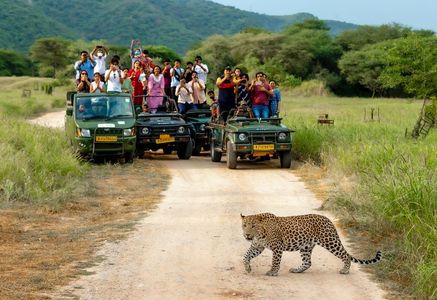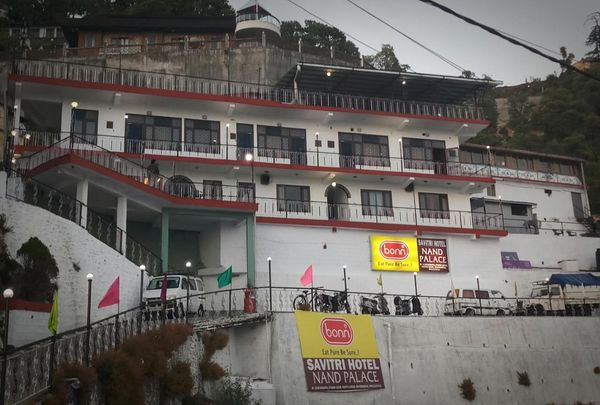Silent Shadows: The Thrill of Spotting a Leopard in Jhalana
 Palakshi Meharwal
29 Jul, 2025
8 mins read
35
Palakshi Meharwal
29 Jul, 2025
8 mins read
35

Tucked away on the outskirts of Jaipur, Rajasthan, the Jhalana Leopard Safari tour provides a rare opportunity to observe leopards in their natural habitat without the need to venture deep into the wilderness. Often overshadowed by India’s more famous national parks, Jhalana has quietly become a gem for wildlife enthusiasts seeking an intimate and uncrowded safari experience. The thrill of spotting a leopard slinking through the underbrush—or silently observing from a tree—is unmatched, especially when it happens so close to an urban landscape.
The Jhalana Reserve: A Unique Urban Wildlife Habitat
The Jhalana Forest Reserve, spread over approximately 23 square kilometers, is situated just 10 kilometers from the heart of Jaipur. What makes Jhalana extraordinary is its ability to support a robust leopard population within a relatively small and enclosed area surrounded by the growing city. As of recent estimates by the Rajasthan Forest Department, the reserve is home to over 35 leopards, with frequent sightings reported by safari guides and visitors alike.
This makes Jhalana one of the most reliable locations in India to spot a leopard—often within the span of a single safari session. The absence of larger predators such as tigers allows leopards to dominate the food chain here, increasing their visibility and movement throughout the reserve.
The Leopard: Elusive, Elegant, and Ever-Watchful
Unlike lions that often roam in prides or tigers that make grand, solitary appearances, the leopard is a master of stealth. Their golden coats, dappled with rosette-like spots, blend seamlessly with the dry deciduous forest of Jhalana, making them a challenge to detect unless they choose to reveal themselves.
Visitors to Jhalana often recount the thrill of the moment when a pair of glowing eyes emerges from the undergrowth or a spotted tail flickers above the grass. These encounters are not just about photography or checklists—they are deeply moving experiences that connect humans to the silent rhythms of the wild.
Timing and Safari Options
Leopards are crepuscular by nature, meaning they are most active during the early mornings and late afternoons. This aligns perfectly with the safari timings in Jhalana, which typically operate in two slots: one just after sunrise and another in the late afternoon.
The best months to visit are October through March, when the weather is pleasant, and wildlife activity is relatively high. During the hotter summer months, leopards often approach waterholes in the early morning, making sightings more predictable despite the heat.
Safaris are conducted in open 4x4 gypsy vehicles, accompanied by experienced drivers and naturalists. These experts not only track animal movements but also interpret behaviors, helping visitors appreciate the subtle dynamics of the forest.
Biodiversity Beyond Leopards
While leopards are undoubtedly the stars of Jhalana, the reserve also supports a range of other fauna. Species such as desert foxes, striped hyenas, Indian civets, and jungle cats share this dry scrubland ecosystem. Birdwatchers will also find plenty to admire, with over 200 species of birds recorded in the region—including peafowls, Indian pittas, owls, and raptors like the crested serpent eagle.
The flora of Jhalana reflects the typical arid landscape of Rajasthan. Dominated by dhok trees, babul, and acacia, the vegetation offers both camouflage and shade for predators and prey alike. Despite its dry appearance, the forest has a complex web of life that is carefully balanced.
Conservation and Community Involvement
Jhalana has undergone a significant transformation in recent years, thanks to conservation efforts and better management practices. It was officially designated as a leopard safari park in 2017, and since then, the local forest department has made commendable strides in preserving its ecosystem.
Importantly, eco-tourism in Jhalana has contributed positively to the local economy. Many of the safari drivers, guides, and support staff hail from nearby villages, and increased tourism has created sustainable livelihoods without causing excessive pressure on the environment.
The reserve also serves as an educational platform, especially for urban school groups and travelers who may never have experienced wildlife up close. Initiatives like guided nature walks and awareness drives help bridge the gap between urban populations and the importance of conserving native species.
Tips for a Rewarding Experience
- Book in Advance: Jhalana is becoming increasingly popular. Booking your safari slot early ensures a hassle-free experience.
- Dress Appropriately: Wear neutral-colored clothing that blends into the surroundings. Avoid bright colors or loud prints.
- Carry Binoculars and Cameras: While leopards may come close, spotting other shy species often requires a keen eye and the right tools.
- Listen to Your Guide: The expertise of the forest guides can make a world of difference. Their knowledge of animal behavior and tracking techniques often leads to successful sightings.
- Be Patient: Leopard sightings can be unpredictable. Embrace the silence and the stillness—it’s often in those moments that nature reveals her most fascinating secrets.
Final Thoughts
In an age where many wildlife experiences are commercialized or overly curated, Jhalana offers something raw and authentic. Spotting a leopard here isn't just about ticking off a box on a wildlife checklist—it's about witnessing a creature of grace and power, moving through a landscape that echoes with ancient rhythms.
Written By:
Palakshi Meharwal



Hotels at your convenience
Now choose your stay according to your preference. From finding a place for your dream destination or a mere weekend getaway to business accommodations or brief stay, we have got you covered. Explore hotels as per your mood.





